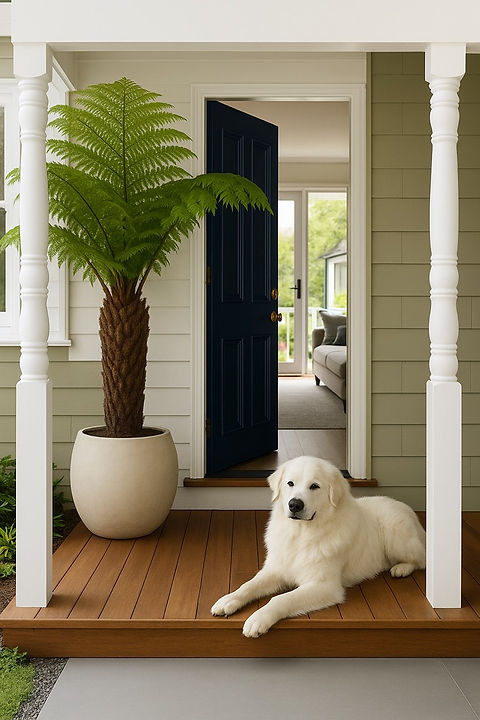Dicksonia antarctica
The Tasmanian Soft Tree Fern
Iconic, Sustainable, and Timeless
The soft tree fern (Dicksonia antarctica) is one of Tasmania’s most recognizable plants, prized worldwide for its lush, architectural fronds and distinctive fibrous trunk. Native to Tasmania’s cool temperate rainforests, it thrives in shaded, moist environments and adds instant impact to any garden or landscape.
Every legally supplied tree fern is issued with a government-approved tag, confirming it has been harvested under strict salvage licensing. This guarantees your fern is sourced responsibly, protecting Tasmania’s forests while giving gardeners confidence in authenticity and sustainability.


Features of Dicksonia antarctica
• Native Tasmanian species with striking fronds up to 4 metres long
• Natural fibrous trunk that stores and absorbs moisture
• Slow-growing habit (3–5 cm trunk growth per year) for longevity
• Hardy in sheltered gardens, tolerating light frosts with protection
• Supplied with official government tags to verify licensed salvage

Benefits of Growing Tree Ferns
• Architectural beauty: Instantly creates a lush, tropical look.
• Moisture-loving: Thrives in shaded, damp areas where many plants fail.
• Long-lived: With care, tree ferns can grow for decades, slowly forming impressive trunks.
• Wildlife habitat: Fronds provide shade and shelter for birds and insects.
• Sustainability assured: Official tags guarantee responsible sourcing under Tasmanian law.

Care Guide for Dicksonia antarctica
Planting
• Select a shaded, sheltered location with moist, well- drained soil.
• Keep the crown above soil level when planting.
• Surround with tree fern mulch to retain moisture and mimic natural forest-floor conditions.
Watering
•Keep both the trunk and crown moist at all times.
•During dry spells, water directly into the crown and over the trunk.
•Drip irrigation or misting helps maintain even moisture.
Feeding
• Apply a slow-release fertiliser formulated for ferns or natives in spring and summer.
• Use liquid fertiliser directly in the crown for fast uptake.
• Avoid high-phosphorus fertilisers that damage sensitive roots.
Where to Apply Fertiliser
Into the Crown:
The growing tip in the centre of the fern is where new fronds emerge. Pour diluted liquid fertiliser or sprinkle slow-release granules directly into the crown. The plant absorbs nutrients here as water trickles down through the fibrous trunk.
Around the Base/Root Zone:
Scatter a light ring of slow-release pellets or granules around the base of the trunk, on the soil surface. This benefits the root system in the ground.
On the Trunk (with liquid feeds):
Because the trunk is fibrous and acts like a sponge, tree ferns can take up nutrients through it. When watering with a liquid fertiliser, run it down the trunk as well as into the crown.


What Type of Fertiliser to Use
Slow-release pellets for ferns or Australian natives
• Choose a low-phosphorus formula (look for “safe for natives” or a phosphorus level under 3%).
• Osmocote Native or similar products are safe choices.
Liquid fertilisers for ferns or seaweed extracts
• Seaweed or fish-based tonics (like Seasol) encourage root growth and resilience.
•Dilute well and apply into the crown and over the trunk.
• Avoid high-phosphorus fertilisers (standard general-purpose or tomato fertilisers), as they can damage the fern’s sensitive root system.
Seasonal Timing
•Spring to early autumn:
Best time to apply slow-release fertiliser (every 2–3 months).
• Winter: Growth slows down, so reduce feeding and just maintain moisture.
Quick Rule of Thumb:
• Crown = main target (new growth).
• Trunk = secondary uptake (especially with liquids).
• Root zone = steady background nutrition (with pellets).
Protection
•Tolerates light frosts, but protect the crown in severe cold with straw or mulch.
• Shelter from strong winds to prevent frond damage.
• Leaving old fronds attached provides natural insulation.


Why Use Tree Fern Mulch With Your Fern?
When planting or maintaining Dicksonia antarctica, tree fern mulch is the perfect companion product:
• Moisture retention: Keeps the root zone consistently damp, reducing stress on the fern.
• Soil improvement: Breaks down slowly to enrich soil structure, supporting long-term health.
• Weed control: Dense and fibrous, it suppresses weeds that would otherwise compete for water and nutrients.
• Natural synergy: Being from the same species, it recreates the fern’s native forest-floor conditions more closely than any other mulch.
• Safe for sensitive plants: Gentle texture ensures no damage to young roots or delicate crown tissue.

Recommended Uses
• Feature plant in shaded courtyards or rainforest gardens
• Group plantings for layered canopy effects
• Container planting in large pots with regular watering
• Companion planting with ferns, orchids, and moisture-loving natives
• Always paired with tree fern mulch for best results

Sustainability and Government Tags
All tree ferns supplied in Tasmania are regulated under government licensing. Each plant carries an official numbered tag, proving it was harvested legally and sustainably. This ensures buyers are supporting ethical practices while protecting Tasmania’s unique rainforest ecosystems.
Order Dicksonia antarctica
Available in a range of sizes, each tree fern is supplied with a government-issued tag to guarantee authenticity. Pair your fern with tree fern mulch for the best start — a sustainable, natural match that ensures long-lasting health and growth.
